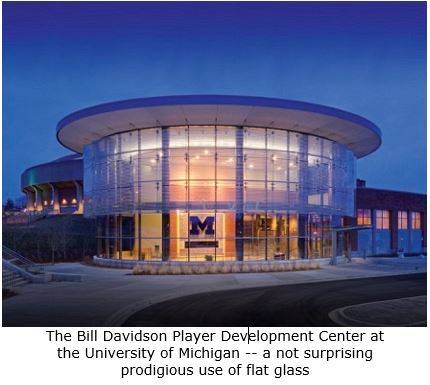The Double Steal – the Right and Wrong Way to Steal Trade Secrets
By Gregory Stejskal (1975-2006)
It took about 5,000 years from the discovery of glass until a process was developed to economically mass produce flat glass, and only a few years before the technology was stolen.
Glass is one of the great fundamental inventions – not at the level of the wheel or fire, but up pretty high on the list. Glass is chiefly made from relatively common and inexpensive raw materials: sand, soda ash (sodium carbonate) and lime.
No one knows when glass was first invented or by whom. It does occur in nature when lightning strikes sand or sometimes from volcanic eruptions (obsidian). Its first use seems to have been as a glaze (faience) for ceramic vessels in about 3,000 BCE. It wasn’t until about 1,500 BCE that glass vessels were produced in Egypt (ultimately used to hold beer, one of my favorite inventions). The use of a pipe for blowing superheated glass wasn’t invented until circa 30 BCE.
Through the ages, uses for glass have multiplied and are as diverse as flat glass to optical lenses which enabled the development of telescopes and microscopes. But this story is about the technology to produce flat glass, and why some people would go to great lengths to steal it.
Flat glass is used primarily for windows and doors on homes, buildings and vehicles. Until relatively recently, there wasn’t an economical way to produce large quantities of quality flat glass.
Flat glass was originally made by blowing cylinders of glass that were cut open and flattened then cut into panes. Most window glass up until the early 1800s was made using the cylinder method. The cylinders were limited in size. They were 6-8 feet (2-3m) long and 10-14 inches (~30cm) in diameter, thus limiting the size of the panes that could be cut. Large windows had to be made of multiple panes.
In 1848, Henry Bessemer, an English engineer, designed a system that produced a continuous ribbon of flat glass by forming the ribbon of molten glass between rollers. This was an expensive process as the surface of the glass had to be ground and polished. This did overcome the size limitations of the cylinder method. Beginning in the 1920s, a continuous ribbon of glass was passed through a lengthy series of inline grinders and polishers, reducing glass loss and cost.
The major breakthrough in the production of flat glass didn’t come until the late 1950s. Sir Alastair Pilkington and Kenneth Bickerstaff of Pilkington Brothers, Ltd. in the UK developed the first successful commercial float glass process.
Float glass uses common glass-making raw materials. The materials are mixed with cullet (waste glass) in a furnace, where it is heated to ~2,800 degrees F (1,500C). When the mixture becomes molten, it is allowed to pour onto a “tin bath,” a bath of molten tin about 2.3 inches (6cm) deep, 3-4 feet (3-4m) wide and 150 feet (45m) long. The glass enters via a canal. The speed and volume of glass flow is controlled by a gate called a twill. The glass literally floats on top of the tin with uniform thickness. (The molten tin does not adhere to the glass, but an oxygen free atmosphere has to be maintained to keep the tin from oxidizing and adhering to the glass.) As the glass flows along the tin bath, the temperature is gradually reduced. At the end of the bath, the glass has cooled to approximately 1,100F (600C). At that temperature, the glass can be lifted from the bath onto rollers. The glass ribbon is pulled by the rollers at a controlled speed. The speed at which the glass is pulled determines its thickness.
 As the glass is pulled from the bath, it passes through a lehr (a type of kiln), where it gradually cools so that it anneals and does not crack from more rapid temperature change. After exiting the lehr, the glass is cut by machines.
As the glass is pulled from the bath, it passes through a lehr (a type of kiln), where it gradually cools so that it anneals and does not crack from more rapid temperature change. After exiting the lehr, the glass is cut by machines.
Pilkington Bros. patented the process to protect the substantial cost of development and have a competitive advantage. Virtually all flat glass is now made using the float glass process including the glass for car windshields and windows.
Since the time of Henry Ford, Ford Motor Co. has embraced the industrial strategy of vertical integration. That is not only building cars, but producing the raw materials and many of the car’s components. This included the glass and fabrication of the windshields and windows.
Ford realized that the float glass process was not only more efficient, it produced superior flat glass with consistently better visibility – a very important characteristic for windshields. Consequently, Ford negotiated with Pilkington Bros. and obtained the licensing rights to manufacture glass using the float process. Ford built a float glass plant at their Rouge complex. (Located on the Rouge River just west of Detroit, the Rouge complex was at one time the largest industrial complex in the world.)
In 1932, Guardian Glass Co. was originally established as a small fabricator of windshields in Michigan. William (Bill) Davidson, a nephew of the company’s owner became the CEO in 1957 just ten years after graduating from the University of Michigan. (The late Bill Davidson might be better known as the owner of the Detroit Pistons during their heyday as NBA champions. Those teams were known as the “Bad Boys.”) Davidson had Guardian declare bankruptcy and reorganized the company under Chapter 11.
After three years with Davidson at the helm, Guardian came out of bankruptcy, but continued to struggle. Although Guardian had obtained the contract for all of the windshields for American Motors, it was clear that to be more profitable, they would have to produce their own glass. They had been buying the glass they used from glass producers, primarily Ford. The U.S. glass industry was dominated by an oligarchy of three companies: Pittsburgh Plate Glass (PPG), Libbey Owens Ford and Ford. Davidson concluded Guardian needed to be a glass producer.
Davidson set out on an audacious plan. He hired away Ford’s chief glass engineer, Ed Sczesny, and began planning to build a float glass plant in Carlton, MI. Clearly Sczesny brought proprietary trade secret information with him. Guardian made a perfunctory request of Pilkington to obtain licensing rights, which Pilkington denied. Pilkington threatened to sue if Guardian moved forward with the float plant. Davidson gambled that Pilkington wouldn’t sue as it risked jeopardizing its entire worldwide licensing program if it sued Guardian and lost.
Construction on the float plant began in 1969, and was completed at a cost of about $17million. By the middle of 1970, the plant was producing 350 tons of glass per day. Guardian reached an ongoing royalty licensing agreement with Pilkington in 1971, but at substantially lower amounts than the other U.S. licensees paid. The lower payments were based on Pilkington’s not having provided any technical assistance to Guardian. (This must have been troubling to Ford, who was paying the higher licensing fees, and lost their chief glass engineer.)
The gamble had paid off. Today, Guardian is one of the four largest manufactures of flat glass in the world. It has 18,000 employees with plants in 21 countries. Davidson became a billionaire and a philanthropist. He donated millions of dollars to different causes and institutions. Among them was the University of Michigan, to which he donated $55 million.
 A Turkish-American engineer, John Akfirat, working for Ford as glass engineer was aware of what Davidson and Sczesny had done. In 1973 Akfirat stole the blueprints for the Ford float glass plant. Ford discovered Akfirat was trying to sell their plans and his expertise and notified the FBI. The FBI used an undercover Agent posing as a potential buyer to approach Akfirat. The plans were seized and Akfirat was arrested and prosecuted. Akfirat pleaded guilty and served a short jail sentence.
A Turkish-American engineer, John Akfirat, working for Ford as glass engineer was aware of what Davidson and Sczesny had done. In 1973 Akfirat stole the blueprints for the Ford float glass plant. Ford discovered Akfirat was trying to sell their plans and his expertise and notified the FBI. The FBI used an undercover Agent posing as a potential buyer to approach Akfirat. The plans were seized and Akfirat was arrested and prosecuted. Akfirat pleaded guilty and served a short jail sentence.
In the 1980s, a foreign source reported that a float glass plant was being built in Romania. (This was during the Cold War and Romania was part of the Soviet Block.) The source also reported that Akfirat was involved in the construction of the plant. Reportedly Akfirat had been travelling to Romania from his home in Ann Arbor, MI, during the period when the plant was being constructed, 1975-1981. The case was presented to the U.S. Attorney in the Eastern District of Michigan and an investigation was authorized.
Primarily based on the source information and Akfirat’s past record, a search warrant was obtained for Akfirat’s residence in Ann Arbor. Found pursuant to the search warrant were plans for a float glass plant and documents indicating Akfirat had been in contact with the Romanians, and had travelled to Romania to help with the construction of the glass plant.
The plans found in the search for the Romanian plant were taken by the FBI to Pilkington Bros. in St. Helens, UK (near Liverpool). The “Romanian” plant was smaller than any plant that Pilkington or any of its licensees had ever built, but Pilkington engineers determined there were several unique characteristics in the Romanian plans, which proved they had used patented and or secret technology to build the plant in Romania.
Akfirat was again prosecuted and again pleaded guilty in US District Court to one count of wire fraud. He was cooperative, and maybe a mitigating factor was the Romanian plant was never successful in producing quality flat glass, or maybe the judge understood that Akfirat was just trying to execute a double steal.* He was sentenced to probation.
Akfirat had been charged federally with wire fraud because at the time, there were no federal statutes specifically addressing the theft of “trade secrets.” In 1996, federal statutes were enacted outlawing economic espionage and the theft of trade secrets (18 USC 1831, 1832). I’m not aware that criminal prosecution was ever contemplated for Davidson and Sczesny’s theft of trade secrets, but had these laws been on the books, they could have been prosecuted.
*In baseball, a double steal is a strategy in which two base runners attempt a stolen base on the same play.